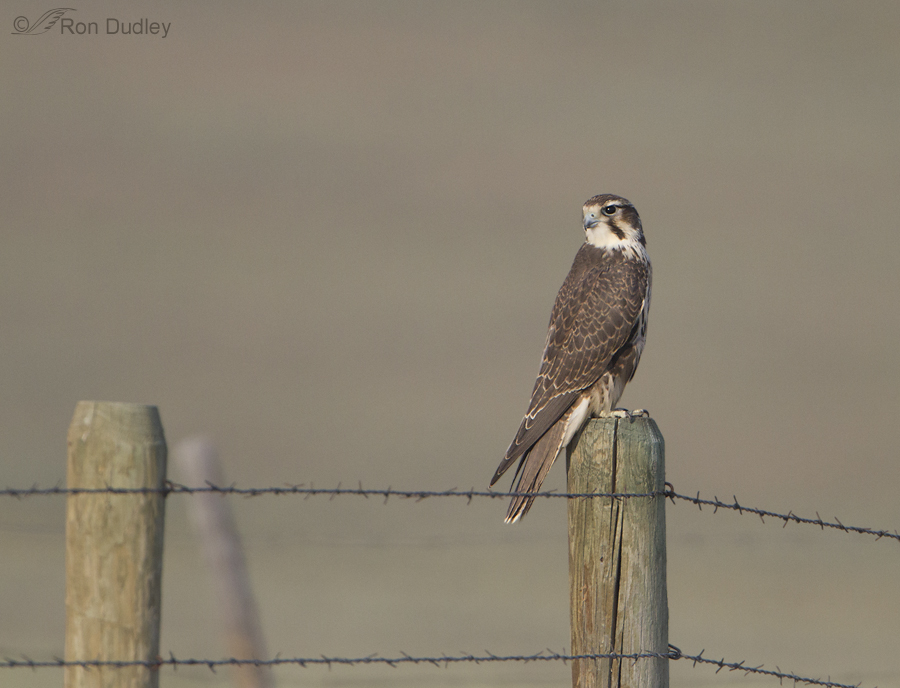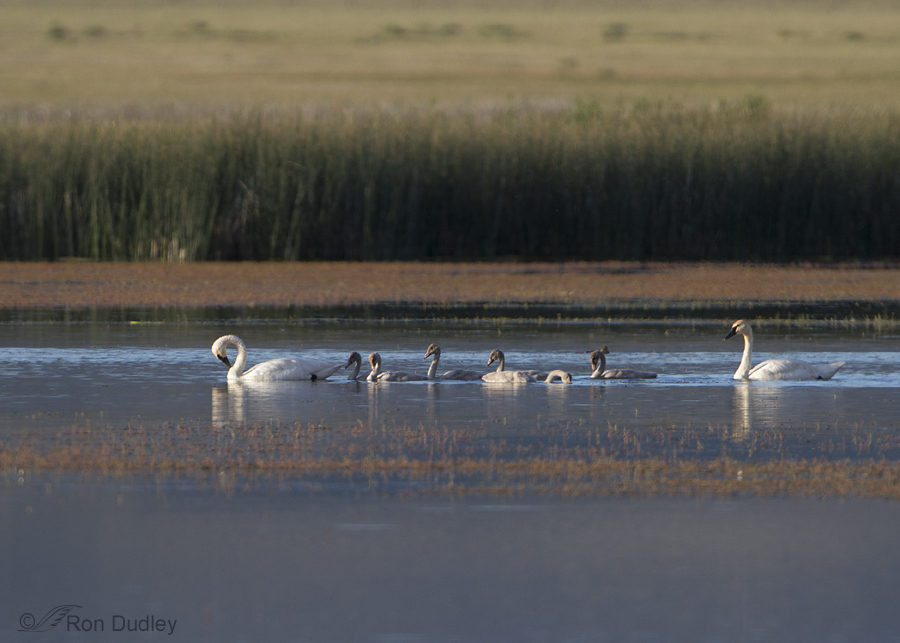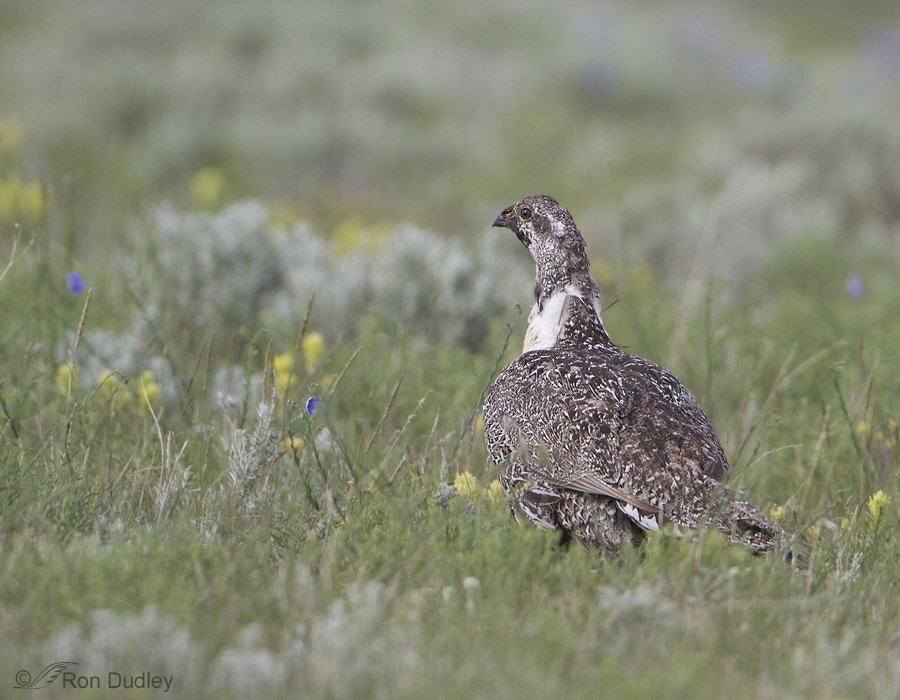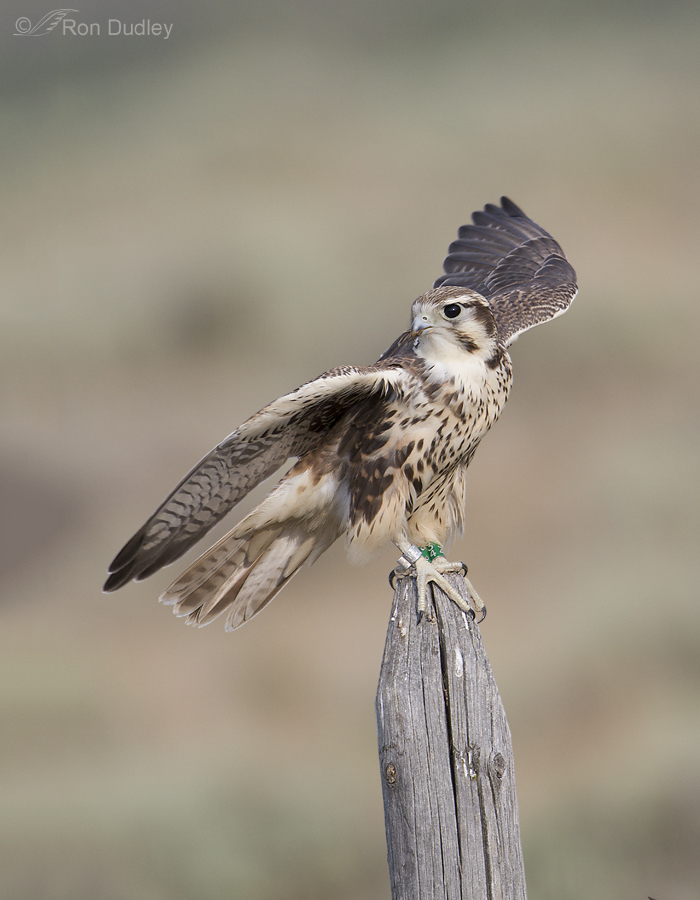Tag: centennial valley
Montana Prairie Falcons And Hordes of Grasshoppers

I learned something last week in Montana’s Centennial Valley – Prairie Falcons eat insects.
In the past I’ve only seen them eat birds and small mammals and cursory research had backed up that observation but if you dig a little deeper in your research (Birds of North America Online, for example) you’ll find mention of lizards and insects being included in their diet. My friend (master falconer) Mark Runnels says that “Prairie Falcons will eat anything. In really bad years I have even heard of them feeding on carrion. You’ll never see a Peregrine do that!”
Trumpeter Swan Pair With Six Cygnets

Trumpeter Swans are the largest of all North American waterfowl, weighing up to 30 pounds and having a wingspan of as much as 8 feet. It’s hard to imagine that by the 1930’s this species had been almost wiped out. In 1949 the Director of the U.S. Fish and Wildlife Service said that the Trumpeter Swan was “the fourth rarest bird now remaining in America”. But thankfully recent intense swan restoration and management programs have brought the species back from the brink of extinction.
An Unlikely Alliance To Save The Greater Sage-Grouse

The Greater Sage-Grouse is a spectacular bird in many ways. They’re our largest grouse – males may approach 7 lbs. The dramatic breeding display of the males on the lek is mind-boggling. And to have one of these birds flush at your feet is literally a heart-stopping experience – something I know from experience.
But these birds are in great danger of extinction due to dramatic loss of habitat.
A Few Mammals For A Change
I’m primarily a bird photographer but when I’m in the field I do see other types of wildlife and I’m not hesitant to photograph them in the least.
Short-eared Owl With Prey, Coming At Me
I’m always happy when I can get decent images of an owl in flight. If they’re carrying prey it’s a bonus. And if the bird is flying toward me I often consider it icing on the cake – partly because those kinds of shots are so very often baited, decoyed, set up or called in. As always for me, these were not. I’ve posted one of these shots before but I hoped it might be interesting for some to see a sequence of images as this adult male Short-eared Owl flew toward me with a vole for its mate before veering off to my right. 1/1000, f/5.6, ISO 800, 500 f/4, 1.4 tc, natural light, not baited, set up or called in This first image shows less detail and image quality because the owl was further away as it began to approach me but I decided to include it for context in the sequence. The lower background is sagebrush flats while the upper blues are Montana’s Centennial Mountains in shade. 1/1250, f/5.6, ISO 800, 500 f/4, 1.4 tc, natural light, not baited, set up or called in Four frames later the owl was significantly closer and flew almost directly at me before veering off – a pattern it followed more than once. I’d guess that it was his way of checking me out for any potential threat before delivering the vole. 1/1000, f/5.6, ISO 800, 500 f/4, 1.4 tc, natural light, not baited, set up or called in Which he’s doing intently here. Eye contact can’t be much…
Short-eared Owl Taking Off In Low Light
This male Short-eared Owl was taking off from the sagebrush plains of Montana’s Centennial Valley. 1/1600. f/5.6. ISO 800, 500 f/4, 1.4 tc, natural light, not baited, set up or called in I got three shots in the sequence that I liked well enough to keep. At lift-off he was heading mostly in my direction. I was shooting from my pickup and the vehicle didn’t intimidate him in the least. 1/2000. f/5.6. ISO 800, 500 f/4, 1.4 tc, natural light, not baited, set up or called in Almost immediately he began to veer off to my left… 1/1600. f/5.6. ISO 800, 500 f/4, 1.4 tc, natural light, not baited, set up or called in and then gave me a side view as he flew off to hunt voles for his family (female and two chicks). I’ve never posted this sequence before because the very low light forced me to shoot at ISO 800 which is really pushing it for my Canon 7D so there’s some resulting noise in the images. I don’t like to use noise reduction but I’ve applied it to the backgrounds only for this presentation. Like I said in my last post, every image has strengths and weaknesses and the low light I was dealing with (especially for flight shots) forced me into some compromises for these images. They may not be perfect but I’m still happy to have them. Ron
The Seldom Seen Wilson’s Snipe
Wilson’s Snipe is an elusive species. Relatively little is known of its habits due to its crepuscular nature, cryptic coloration and marshy habitat. Even with as much time as I’ve spent on their stomping grounds I can count on one hand, with a few fingers amputated, the number of times I’ve photographed a snipe. Typically it’s only seen as it flushes in zigzag flight, calling out with its raspy voice. What an interesting bird! The word snipe is derived from “snite” – a variant of snout and you can see why. Their eyes are set remarkably far back on their head, giving them full vision on both sides and binocular vision to the rear. This allows them to see predators approaching from behind, even while their beak is buried in the mud. 1/640, f/6.3, ISO 500, 500 f/4, natural light I found this bird along the Red Rock River in Montana’s Centennial Valley. It was a low light situation so I didn’t have much shutter speed and I was mildly surprised to get the beak sharp as it was calling. The snipe gave me only a few seconds before it flew off, scolding me as it went. Ron
Swainson’s Hawks Of Montana’s Centennial Valley
On my trip to Montana’s Centennial Valley last month Swainson’s Hawks were very abundant. I found two families of them that would reliably hunt close to a road and since they had become habituated to the traffic they were easier for me to approach as long as I stayed in my pickup truck. 1/1000, f/7.1, ISO 500, 500 f/4, 1.4 tc This was one of two juveniles along the river at the west end of the valley. Both birds, along with their parents, would repeatedly perch on posts and poles close to my pickup. But it was very difficult to get an acceptable light angle at this location in the morning so I include only this one shot of those birds. 1/2000, f/6.3, ISO 500, 500 f/4, 1.4 tc I had more luck with another family (two juvies and one parent) at the east end of the valley. The light angle was better and I also preferred the fence posts in this area – they were older and had more character. 1/500, f/11, ISO 500, 100-400 @ 400mm Occasionally I was able to get both juveniles in the same shot but of course that situation often brings with it a depth of field problem so I switched to the 100-400 zoom and set my aperture at f/11 and focused on the post between the two birds. It seemed to work pretty well. 1/2000, f/6.3, ISO 500, 500 f/4, 1.4 tc I loved the “butterscotch” colors on these two juveniles – particularly this one. 1/2000,…
Juvenile Willets In Montana’s Centennial Valley
On my mid-July trip to the Centennial Valley I spent several days with an adult Willet and two juveniles. I reliably found them foraging for insects where a dirt road met Lower Red Rock Lake. Most of the shore birds and wading birds in this area are truly wild and difficult to approach but these three birds were the exception as they repeatedly let me get close as they fed and preened. 1/2500, f/7.1, ISO 400, 500 f/4 This was the most perfectly coiffed of the two juveniles, as the other youngster had a patch of unruly feathers on the back of its head and upper neck. 1/2500, f/7.1, ISO 500, 500 f/4 This particular site provided a bountiful Arthropod smorgasbord for the willets, both in the water and on the shoreline. The birds would feed on aquatic insects and crustaceans in the shallow water for a while and then get a little variety in their diet by coming up onto the shore and gobbling down hordes of terrestrial insects. Here, the more unkempt juvie (notice the fluff of feathers on the back of the head) feeds on a variety of dipterans that it flushes from the vegetation. I’ve cropped this image unconventionally to show more of the “bugs” in the air. I didn’t get a catch light in this shot but this image showed the insects best. 1/2000, f/7.1, ISO 400, 500 f/4. 1.4 tc At times some of the insects almost seemed to dare the Willets to pluck them out of…
Short-eared Owl Displaying Ear Tufts
Short-eared Owls are always a primary photographic quarry for me whenever I visit the Centennial Valley in sw Montana but on this last trip I only found one. However, that lone bird made up for it by showing me something fairly unusual. 1/1600, f/5.6, ISO 500, 500 f/4, 1.4 tc These owls have short ear tufts (“ears”) but they are only rarely seen because they are usually laying down on the top of the head. Here they can be seen, but just barely. 1/2000, f/5.6, ISO 500, 500 f/4, 1.4 tc However, when the bird turned to face me for just a moment the tufts became visible. Typically they are only erected in a defensive pose and I don’t know if this owl deliberately displayed them to me because it thought I was too close or if a breeze from the back lifted them involuntarily. I suspect it was the latter because in the shots right after this one other feathers on the head look to be blown erect by the breeze. Either way I was glad to see the tufts. I have hundreds of images of this species and very few of them show the “ears”. Ron
Rustic Red-tail
This is another Montana Red-tailed Hawk, photographed in Beaverhead County a few weeks ago. 1/1000, f/5.6, ISO 640, 500 f/4, 1.4 tc I tend to like rustic settings like this for raptors in general but particularly for Red-tails because they have adapted so well to our rural habitats. 1/800, f/9, ISO 500, 500 f/4 This hawk was hunting from the post and changed positions on the perch several times to get a better view in different directions. 1/1250, f/7.1, ISO 500, 500 f/4 Soon the bird went into stretch mode. 1/500, f/7.1, ISO 500, 500 f/4 But eventually it spotted something of interest on the ground (and very close to me) and flew down to investigate. It didn’t find any prey and here it is looking back toward the fence – deciding which fence post to use for its next perch. 1/1000, f/7.1, ISO 500, 500 f/4 It chose another near-by post to hunt from but that hunting station didn’t last long because… 1/1000, f/7.1, ISO 500, 500 f/4 a very aggressive robin took exception to this new location. 1/500, f/7.1, ISO 500, 500 f/4 The hawk took the bombardment for a short period but eventually took off in apparent exasperation – with the angry robin continuing to buzz the raptor all the way. The more time I spend with raptors the more I realize just how much harassment they get from other bird species. At times they seem to have no peace whatsoever….
Swainson’s Hawk Take-off
A couple of weeks ago I watched as a couple of juvenile Swainson’s Hawks hunted grasshoppers on the ground in Montana’s Centennial Valley. The birds were often largely obscured by grasses so I waited for take-off. . 1/2000, f 7.1, ISO 500, 500 f/4, 1.4 tc In a situation like this it’s usually very difficult to lock and maintain focus on the bird as it takes off because of the closeness of the grasses in the background – typically autofocus tries to lock on to the background elements when they’re this close to the subject. But in this case there was enough contrast between the light-colored grasses and the relatively dark bird that I was able to get 13 images where the bird was sharp and no body parts were clipped. The problem with many of them (as often happens) was that the timing of the wing flaps was synchronized with the burst rate of my Canon 7D and the wing position in many of those shots wasn’t ideal. I wasn’t bothered by the flying insect below the bird for two reasons: 1), it amused me because it almost looks like the bug is taking flying lessons from the hawk and 2), it was natural and it was there. 1/2000, f 7.1, ISO 500, 500 f/4, 1.4 tc When I get similar shots such as these I can’t help comparing the strengths and weaknesses of each. I prefer the better eye contact in the first image but like the wing and tail position and better light under the wing…
Fascinating Folks of the Centennial Valley, Montana – Living and Dead
The Centennial Valley of sw Montana is one of my favorite places on the planet. It has birds galore, lots of wildlife, beautiful scenery and blessed isolation. It’s not an easy place to visit for the casual visitor as one must negotiate many miles of dirt/gravel roads just to get there and then usually contend with wild weather and the utter lack of services – including restaurants, gas stations and motels. In my many trips to the area I’ve had innumerable flat tires, been stuck in bad weather for days on end and taken home hundreds of pounds of mud, rocks and cow poop that attached to the underside of my pickup and camping trailer and had to be hosed off on my driveway. But I love the place! One of the many holds the Centennial Valley has on me is the fascinating history of the region. I’m a huge fan of western history in general – especially that of Utah and Montana and the valley is dotted with abandoned homesteads dating back to the 1890’s. This area had to be one of the most difficult areas in the lower 48 states for settlers to simply survive, much less eke out a living – as evidenced by the fact that there were many more people trying to live in the valley back then than are found there now. The history of the valley is filled with tales of hardship, danger and incredibly interesting characters including indians, trappers, hunters, miners, homesteaders, squatters, cowboys, sheepmen, rustlers and moonshiners. It’s not my purpose to recount the detailed…
A Mated Pair Of Red-tailed Hawks
Our recent trip to the Centennial Valley of sw Montana lasted 6 days. On the last morning, only an hour or so before we had to leave, we found these cooperative adult Red-tailed Hawks. I couldn’t believe our luck – warm, early morning light coming from the right direction, a clean natural perch, an interesting and varying background with clouds and blue sky, they allowed us close to them for over 20 minutes and there were two of them! 1/800, f/9, ISO 500, 500 f/4. 1.4 tc When we first found them they were perched together. I strongly suspect they’re a mated pair (though I don’t know that unequivocally) since they’re adults and many Red-tails stay paired year-round. 1/1250, f/7.1, ISO 500, 500 f/4. 1.4 tc The two birds stayed together on the perch for almost 10 minutes as we photographed them and then one of them flew off. 1/1250, f/7.1, ISO 500, 500 f/4. 1.4 tc The hawk left behind immediately decided to occupy the vacated perch… 1/1250, f/7.1, ISO 500, 500 f/4. 1.4 tc and did so for some time. 1/500, f/7.1, ISO 500, 500 f/4. 1.4 tc But the bird that flew off landed in a nearby conifer and immediately had to contend with a pair of very aggressive and persistent American Kestrels. 1/1600, f/7.1, ISO 500, 500 f/4. 1.4 tc Soon the kestral-harrassed hawk returned, only to find its preferred perch already occupied. 1/1600, f/7.1, ISO 500, 500 f/4. 1.4 tc There was some…


